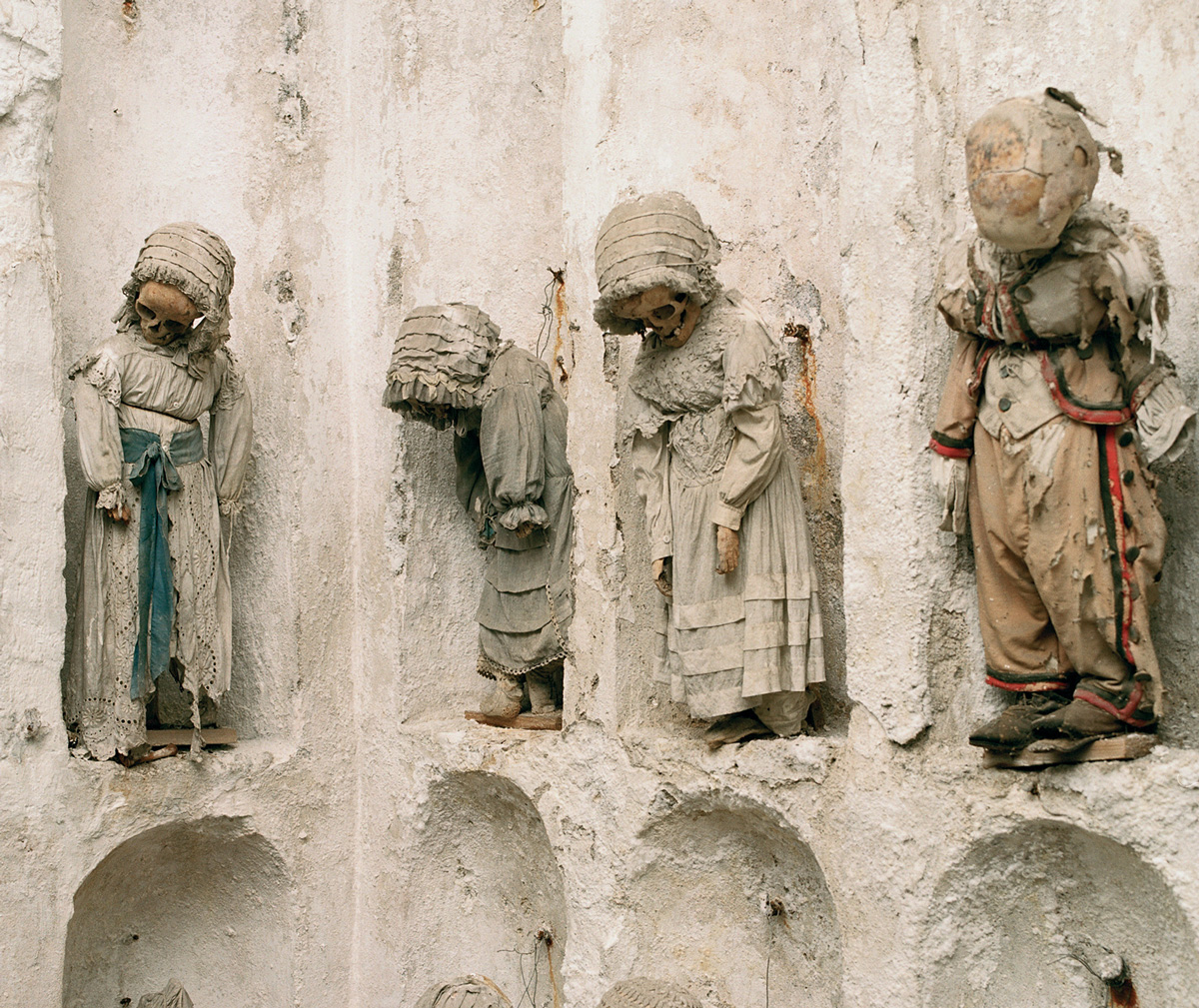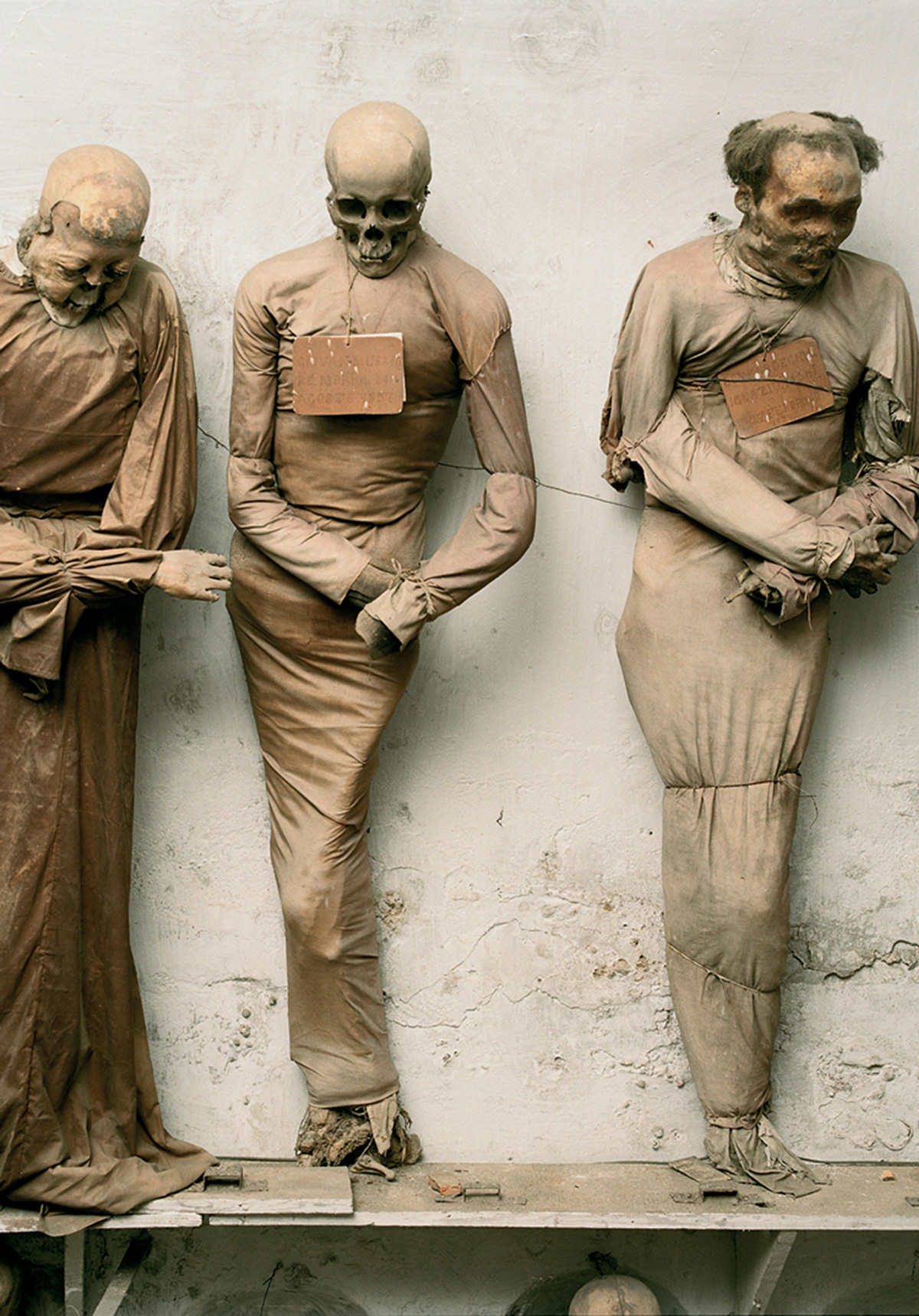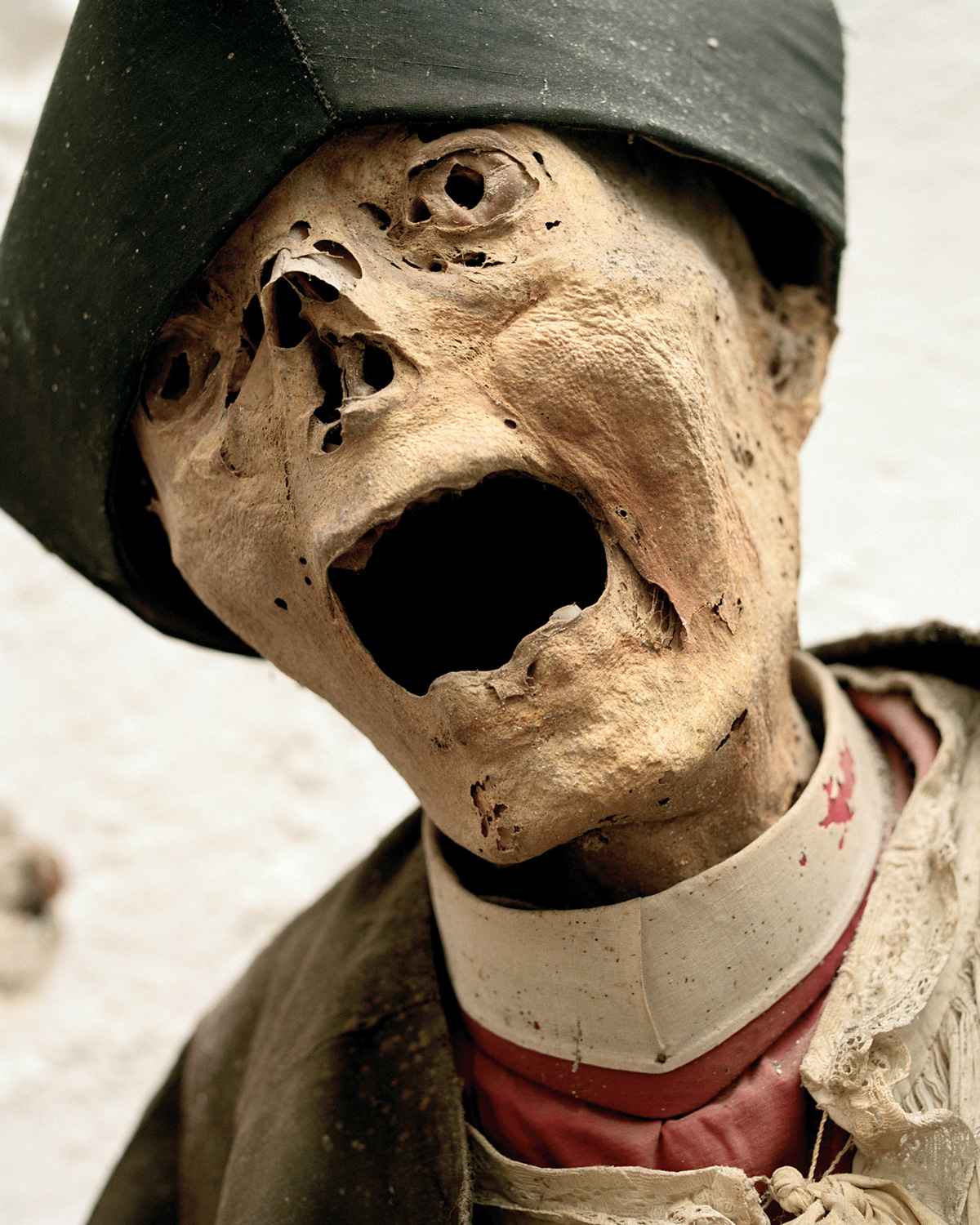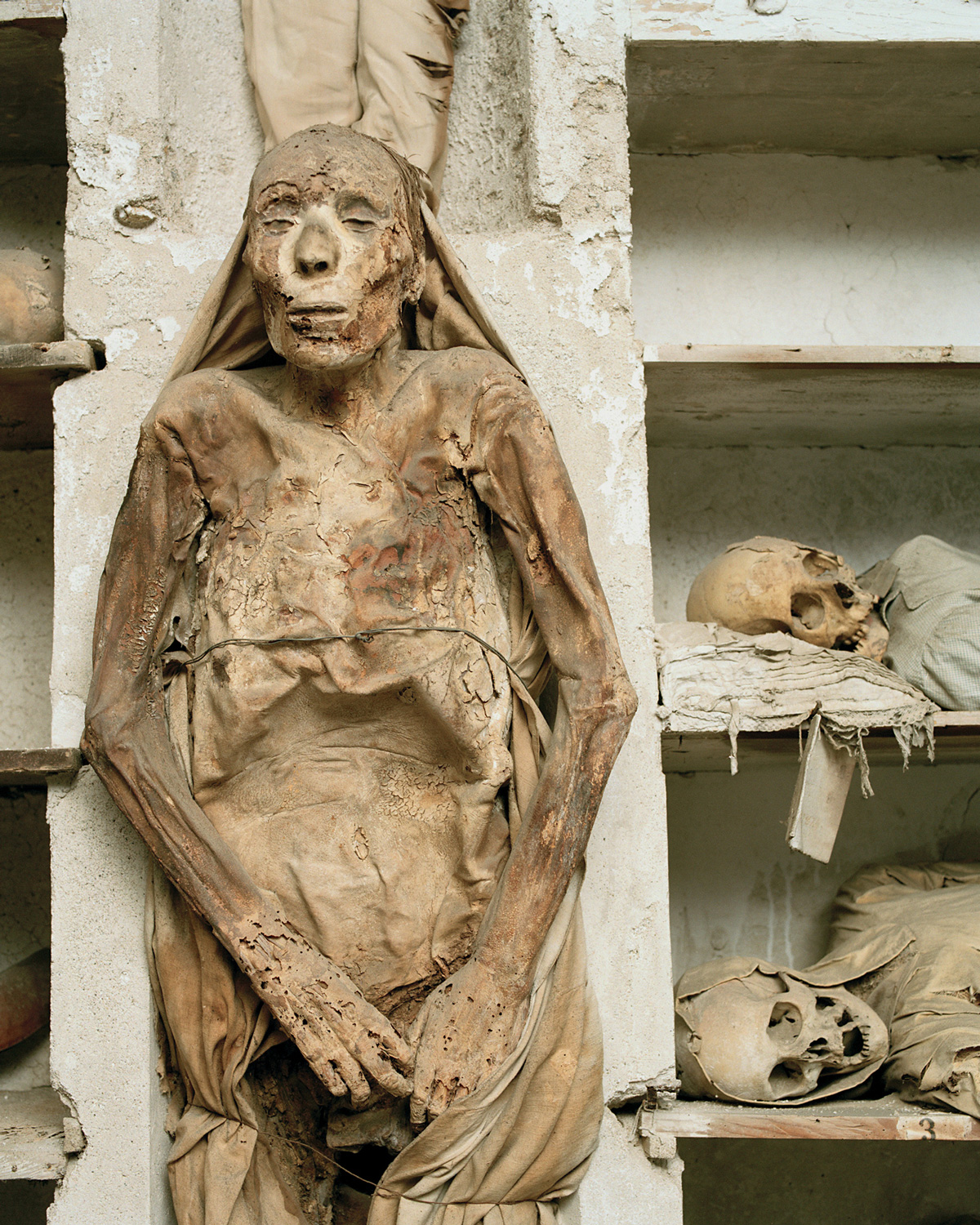The Museum of the Dead
Monochrome macabre
Robert Harbison

Not far from our hotel in the center of Palermo is Oratorio di San Lorenzo, a little Baroque church founded by one of those orders that looks after the unwanted dead. The space is crammed with plaster skulls and skeletons, mostly painted, but the last chapel on the right held what we had come to see: matching pairs of stucco corpses by the sculptor Giacomo Serpotta, who could impart life and motion to all kinds of unlikely entities, such as abstract Virtues and tired old scriptural stories. These are called skeletons in the guidebook, but at least half the flesh still clings to the bones, especially on the chest and diaphragm. They’ve also kept their original grime; in the shadows, the stark white flesh is almost black with it.
We’ve had a rich diet so far of Baroque churches like this one, mostly decorated in that amazing flat brocade of colored marbles that is a specialty in Palermo. In my memory, a conflation has occurred between the piles of meat and fish and plastic toys that line so many of the streets and the fleshy marbling, resembling slices through a huge carcass, that stretch from floor to cornice on the inner surfaces of churches. So, perhaps in an unconscious search for antidotes to clear the spiritual digestion, today we have opted to see ruins of various kinds in the less dense outer parts of the city.
I debated at unbearable length about whether to come out at all. I feel like a ghost, and my first stop was the local pharmacy where they gave me a remedy whose name I recognize, and fear. Sometimes one can be purged of an illness by the mere thought of the brutality of the cure.
The texture of the inner core of Palermo was opened up significantly by Allied bombing in 1943, many scars of which remain. But the old outskirts are nonetheless much more spacious than the core, though almost as dingy. The square with the Capuchin catacombs seems particularly unlovely and nondescript, and it makes me think of a piece of science fiction I read in the fifties, set in a future where the city has sunk into gray squalor because the whole populace is indoors watching an enhanced version of TV.
The most striking ornaments in the square are a couple of gaping holes on the far side of it, unmarked doorways in an undecorated classical portico which someone with a ghoulish sense of humor has tacked onto the stairway leading down into the weird indoor cemetery that draws large crowds of living tourists.
There are no tickets and no reductions for this visit to the underworld. A fat, unspiritual, greasy monk just takes the money and throws it into a basket with unexpected abruptness. A guidebook I buy later dresses up the visit and, after a serious discussion of burial customs in different cultures starting in antiquity, talks about all the artworks lining the stairs going down into the catacombs. I don’t notice these important paintings. It seems a minimal space, stripped bare of all pretense that what lies ahead is anything but grim.
I had formed the wrong idea about this place, expecting the kind of ingenious novelties I’d seen at the Sedlec ossuary in Czechoslovakia, where bones are formed into recognizable objects, including huge chandeliers incorporating each of the 206 bones of the human skeleton, heraldry, and obelisks—memorials composed of exactly what they commemorated. In other words, a grotesque form of play that created illusions by presenting corpses as something else entirely.
In Palermo, however, corpses are treated as characters in a play. Perhaps Walt Disney and Madame Tussaud were inspired by places like this, but the Capuchin crypt will not remind you of their worlds, for in spite of all the talk about the great lengths the monks have gone to in order to create lifelike effects, it feels like somewhere that fell into disuse long ago.

Most of the corpses are wearing clothes, it is true, many of them are sitting up, and whole rows of them are standing. But standing is only a mistake of vision: they are hanging from hooks, so their feet don’t normally touch the ground. And the clothes—there’s a kind of allegory in them. They are so dusty and so faded that the whole picture sinks toward something like monochrome. They remind me of a painter that a friend of mine knew who got the idea of painting indoors with the blinds drawn and the lights off. The results were extremely melancholy: muted colors, indistinct forms.
At first the corpses in Palermo all look the same: stiff, emaciated, and vague in the features. Some of the attempts to keep them straight seem ludicrous. Monks come first, often swaddled in their habits like babies. Then priests; here ecclesiastical ranks are vigorously maintained. Bishops wear miters and more expensive fabrics. But clothes slip down on the shrunken frames and obscure the features, whatever might be left of them. One of the great lessons of the crypt is that clothes decay too; corpses decay first, and then the possessions they bring, becoming corpses of themselves in their turn. You would have to be an expert on eighteenth and nineteenth century costume to make much of the shredded residues. Not quite true perhaps—as in a child’s drawing, you can tell what the clothes are trying to represent and can summon up the right kind of collar or waistcoat from a Daumier sketch you vaguely remember.
The expressions remind you of Daumier too. Once they begin to turn their necks and stretch their jaws, you interpret the corpses’ strategically deployed spasms as interested looks or angry stares or cries of distress. They may be only crude imitations of character, but like a dog who can stand up or a horse who can count, these people hold your attention just because they can manage something like a smile or a pout.

The spatial layout of the whole is exceedingly monotonous. It is a large simple grid with a few loose ends where corridors carry on from a junction to make a dead-end fifty yards further on. In fact, there are no rooms, only corridors, with corpses two deep if they are standing, and three or more if lying along the walls. I turned a corner at one point and got a start: it looked just like one of the famous pictures of Auschwitz at the end of the war with listless emaciated figures lined up for the camera. The whole effect is more like a prison than a dwelling place for corpses, much enhanced by the metal cage extending the whole length along the lower tier, added for security reasons in 1979, according to the guide. So the corpses are much safer now from the depredations of visitors who might like to carry off little bits of them.
In 1979, trumpets the guide, a general restoration took place. What could it have been like before? All the mummified skin on show, all the encouraging plumpness, is fleshed out with straw, which often sticks out of necks and sleeves. The guide complains about fires, street repairs overhead, and, of course, the bombing, all of which have taken their toll on the corpses, but this seems a strange focus in a world where rottenness is really all there is.

By the time I notice that my voice sounds peculiar, blurred, and throaty, it is too late. We have all been breathing the foul air for too long already, luckily without knowing where to look to find the colatoio or colander, where the soft matter drained away from the fresh corpse through stone slats, leaving the parts of the body which the dressers would be able to work with. Like the sanatorium in The Magic Mountain, this is one of those places where every casual visitor ends up a patient at the moment when the nervous joking stops and the infection sets in. Back above ground, the more loosely strung labyrinth of the suburban streets proves confusing in its own way and banishes the morbid thoughts arising from our visit to the dead, but my voice keeps its below-ground timbre for the rest of the day.
Robert Harbison teaches at London Metropolitan University where he is head of the MA Program in Architectural History, Theory, and Interpretation. He is the author of Eccentric Spaces (Knopf, 1977), The Built, the Unbuilt and the Unbuildable (Thames & Hudson and MIT, 1991), and Reflections on Baroque (Reaktion and University of Chicago Press, 2000), among others.